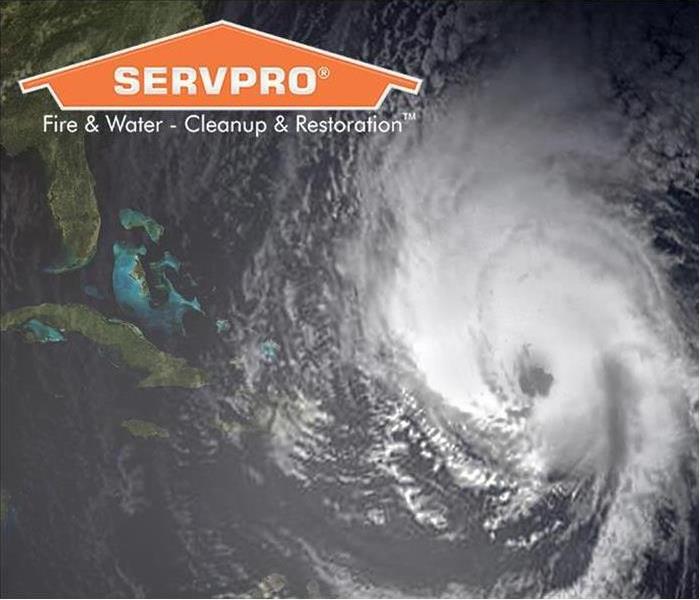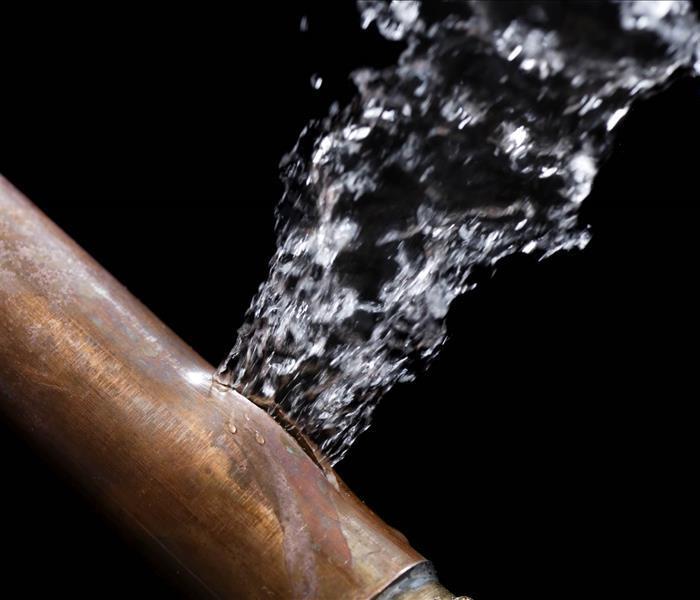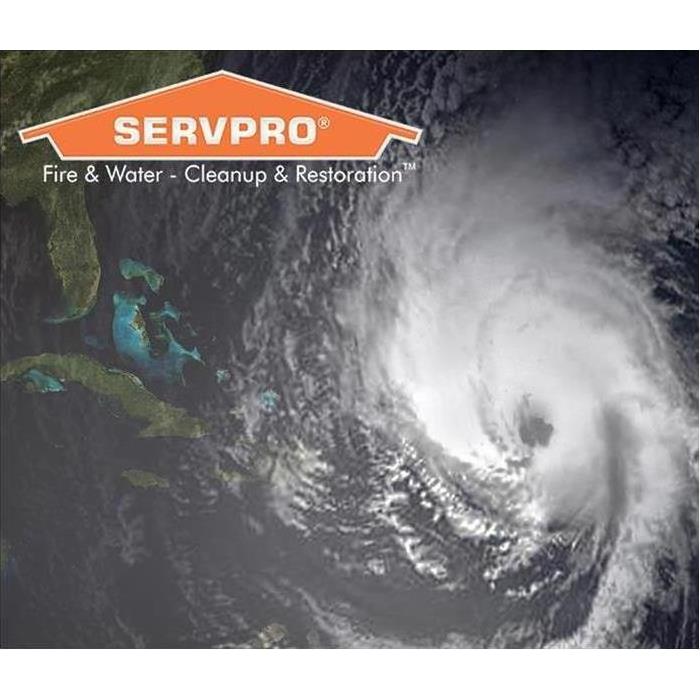Recent Storm Damage Posts
Wind Damage
2/22/2023 (Permalink)
What should you do if you have windy conditions in your area? Take cover next to a building or under a shelter. Stand clear of roadways or train tracks, as a gust may blow you into the path of an on oncoming vehicle. Use handrails where available on outdoor walkways and avoid other elevated areas such as roofs without adequate railing. Watch for flying debris. How do you prepare for windy conditions? you can start by trimming branches away from your house and power lines. Secure loose gutters and shutters. Identify an interior room of your house, such as a basement or interior bathroom, that you can take shelter in during high wind warnings. High sided vehicles are most affected by windy weather, but strong gusts can also blow a car, cyclist, motorcyclist or horse ride off course. This can happen on open stretches of road exposed to strong crosswinds, or when passing bridges or gaps in hedges. Fun Facts about windy conditions you may ask? The fastest winds in the world are found inside tornadoes, where winds speeds can reach more than 250 miles per hour. The wind shapes the planet we live on, in the process of erosion. Winds can be known as a breeze, a gale, a storm or hurricane winds. Meteorologists use barometers to measure air pressure. If you ever have windy damage to your home you should be sure to call SERVPRO and we will take care our you make your damage "Like it never even Happened"
What to do about frozen pipes
1/5/2023 (Permalink)
If a pipe bursts in your home, you’ll need to act fast to mitigate additional damage. It is important to know where your shut off valves are. Shut off your water as quickly as possible. This will help minimize the amount of water that seeps out inside your walls. You may also want to shut off power in the affected area of your home. After you’ve taken these precautionary steps, it’s time to call SERVPRO. Try to remove as much of the water and lingering moisture as you can to avoid mold and mildew buildup. Calling a plumber would be really helpful to fix any broken pipes so that more water does not spread and make your situation worse.
Storm Damage Relief
3/11/2022 (Permalink)
In August 2020, Hurricane Laura devastated Louisiana as one of the most powerful storms in United States history. This storm destroyed homes, businesses, and countless essentials across the state. At one point, over 500,000 people in the state were without power according to Entergy.
Hurricane Delta made landfall in late September, once again showering over Louisiana and yielding high winds. Although not as detrimental as Laura, Delta brought winds of around 100 mph and left multiple areas with 12-17 inches of rain according to meteorologist Mike Doll.
In the months following this disaster, the storm team from SERVPRO of LBL South has been actively assisting the restoration efforts in Lake Charles, Louisiana. Our team has completed jobs for multiple families in Lake Charles, removing affected structural materials and performing mitigation for both water and wind damaged homes.
We want to thank our crew at SERVPRO of LBL South and their families for all their hard work and their dedication to helping those in need.
#HereToHelp
Storm Preparedness
10/13/2021 (Permalink)
Storm Preparedness
Severe weather could include excessive rain/floods, straight line winds, hail, and of course, tornadoes. Are you and your family prepared? Here are a few helpful tips from the National Weather Service:
- BE READY – If you do not have a weather radio in the home, these can be purchased for a reasonable cost at just about any local convenience store or online. It needs to be NOAA certified, and you will need to identify which specific band/frequency to set it to in the event it does not set itself automatically. You can find those HERE, and then identify the frequency for your area, then set your radio accordingly. Make sure the weather radio can both plug in, and operate on some other form of alternative source (batteries, solar, or crank).
- SIGN UP FOR NOTIFICATIONS: Various apps on your Android or Apple phone can alert you to disaster, and guide you once the disaster has concluded. Make sure to have some means of reaching the outside world in the event disaster strikes.
- COMMUNICATION PLAN: In the event you must evacuate your home, or disaster strikes when the family is separated, have a plan for notifying members who reside in the home, as well as other members of concern (immediate family, co-workers, etc.)
- REHEARSE THE PLAN: Run through the communication plan, and overall disaster plan routinely with all members of the household. The plan of action should be second nature in the rare event emergency strikes.
- HELP WHERE HELP IS NEEDED: Once you have secured your home and family, check with neighbors to see if help is needed. Contact emergency services if help is required.
Other helpful tips include making sure your insurance documents, identification, credit card/banking information is all saved digitally in the event your home is destroyed. The more prepared you are, the faster the claims adjuster can work with you to repair/rebuild your home.
SERVPRO of LBL South is an expert in helping make these preparations. Contact the office at (731) 641-1284 and ask to meet with a SERVPRO representative at your home or business to begin building your Emergency Readiness Plan (ERP).
Resources for Additional Information:
National Weather Service Safety Tips
National Oceanic and Atmospheric Administration (NOAA) Radio Frequency Finder
Storm Damage? Now what?
9/9/2021 (Permalink)
Storm Damage? Now What?
Unfortunately, it does happen, hopefully not often. With the changes in our current weather patterns, it seems heavier rains, stronger winds, and overall severe weather seems to be getting more, well….. severe. So what do you do when severe weather strikes your home? Most severe weather damage is a result of wind, which in turn exposes your home to the subsequent rain which enters the interior of the residence. Here are some recommended steps to take immediately if this occurs:
- CALL SERVPRO of LBL South! While the damage may be minimal “looking” early on, you have no idea where the watered entered, nor where it had traveled before it became noticeable to you. It is best to call the professionals who are available 24 hours a day.
- Gather insurance documents and prepare to have those for when SERVPRO of LBL South arrives. It is not mandatory that you have this information in order to call us, however, it helps us to understand how we can assist as we move through the initial inspection process of your home or business.
- Listen closely to the Crew Chief as he/she explains the process, and this is the time to ask any questions as it pertains to the process. Our Crew Chiefs are happy to explain the drying science, as well as how each piece of equipment functions to help restore your home to its normal level of dryness.
- BE PATIENT! Our job as the premier restoration company in the nation is to ensure your home is dry following storm damage. We know the fans and dehumidifiers may be a touch loud, and you may be tempted to turn them off to catch your favorite television series. Do not alter the equipment left behind by a company. If there is an issue with the equipment, please consult with your Crew Chief.
- Be prepared to contact a construction company to replace the materials removed from the home that were affected by the storm. While SERVPRO of LBL South does have a construction team that can restore your home like new, the mitigation process goes much faster than the replacement process. While a standard water damage mitigation can take up to seven days, the restoring of a home following storm damage can take days or even months depending upon the level of damage. It is best to consult with the Crew Chief, AND the Construction Manager on your options as it relates to the restoring of your home.
SERVPRO of LBL South is #HeretoHelp following any storm damage your residence or business may incur. Our emergency line is open 24-Hours a day and we may be reached at (731) 642-1284.
Hurricane Harvey
9/3/2021 (Permalink)
Hurricane Harvey, which hit Louisiana and Texas in 2017, is tied with Hurricane Katrina as the costliest tropical cyclone on record, inflicting $125 billion in damage, primarily from catastrophic rainfall-triggered flooding in the Houston metropolitan area. In a four-day period, many areas received more than 40 inches of rain as the system slowly meandered over eastern Texas and adjacent waters, causing unprecedented flooding. The resulting floods inundated hundreds of thousands of homes, displaced more than 30,000 people, and prompted more than 17,000 rescues.
Two weeks after the initial disaster, we were on scene. Our experience in Houston will be one of the most memorable for our company. Floors, walls, and ceilings were affected in most homes we helped. These surfaces, only days after the waters had receded, were covered in mold. This mold, black mold, had to be removed from the homes. Here is a link to better understand the mold and black mold.
http://www.SERVPROlblsouth.com/black-mold
There were streets upon streets of personal belongings, furniture, pictures, carpet, drapes... piled 6 to 8 feet high on curbs. These were memories... But the people of Houston persevered. The people of Houston, even on their worst days, were some of the most uplifting and optimistic people we've ever met in the face of disaster. A part of my heart will always be in Houston. You are a positive force in our country. It was a pleasure to have met them even in the direst of circumstances.
Safety Tips During a Storm
9/3/2021 (Permalink)
Lightning from thunderstorms injures hundreds of people in the U.S. every year and kills dozens. These casualties are easily preventable if you follow these simple safety tips.
1. Listen to the radio and television for severe thunderstorm warnings. The National Weather Service issues warnings for counties and even sends out text messages now to our mobile phones when storms are on their way. Pay attention and heed their warnings for safety.
2. Remember the 30 second rule. If there is not 30 seconds in between the time you see lightning and hear thunder, it’s time to go indoors.
3. Lightning typically strikes the tallest object around so if there is a storm, move indoors if at all possible or into a hard top car if there are no buildings around.
4. Once inside, stay away from windows, plumbing and electrical. If lightning strikes outside, it can carry inside via land lines.
5. Get out of boats and away from bodies of water. If you can hear thunder than you are close enough to get struck by lightning.
6. If you are caught outside, avoid standing by tall isolated objects such as trees. Find a grouping of small trees surrounded by taller ones, avoid bodies of water, and if there is only open spaces, look for a dry low-lying area and try to make yourself the smallest target possible. Do not lay flat on the ground, rather crouch with your head between your knees. Sheds, outhouses and tents provide no safety so keep this in mind when you are hiking or camping. Always think ahead and be prepared in the event that you are caught in a thunderstorm and if possible, turn around on your trip and head home.
STORM Preparedness
9/3/2021 (Permalink)
National Preparedness Month 2021
September of each year is National Preparedness Month in the United States. SERVPRO promotes this month in an effort to get our friends and local patrons to understand the importance of be prepared for any disaster that could strike. As COVID-19 has brought upon numerous situations for most, if anything, it has stressed the very importance of being prepared. Natural Disasters could include Flooding, Wildfires, Extreme Heat, a Pandemic, Tornadoes, Earthquakes, Lightning Strike, Blizzards, Hurricanes and much more. While we are not immune to some of these because we live in the Southeast, we are vulnerable to most.
Ready.gov, a federally funded website helps with the planning for when disaster strikes. According to Ready.gov, a standard Disaster Supply Kit includes but is not limited to:
- Water (at least one gallon per day per person for no less than three days)
- Food (again, three-day supply)
- Battery powered or hand-crank radio
- Flashlight
- First Aid Kit
- Extra Batteries
- Dust Mask
- Plastic Sheeting by which to build a shelter
- Duct Tape
- Trash bags and Moist Towelettes
- Manual Can Opener
- Cell phone with chargers and a backup battery
Additional supplies would also include any pet supplies, prescription medicine, insurance information, face coverings (during a pandemic or in the event of a biological disaster), feminine supplies, paper and pencil, and more.
Have a plan. Communicate the plan to family members. Rehearse the plan routinely with them and ensure everyone knows communication plans, phone numbers, evacuation plans, meet-up locations and more. Rehearse these so often that everyone knows them by nature, and in the event the worst happens, you and your family will be #ready!
If your home suffers damage from a storm, give SERVPRO of LBL South a call at (731) 642-1284. We are #HeretoHelp!
Resources:
Recommended Supplies List: https://www.ready.gov/sites/default/files/2020-03/ready_emergency-supply-kit-checklist.pdf
Not One Storm, But Two!
2/1/2021 (Permalink)
February 1, 2021
Not One Storm, But Two
Hurricane Laura hit landfall as a Category 4 hurricane in Cameron, Louisiana on August 27, 2020. The storm caused the deaths of at least 77 people in the U.S. and had caused an estimated $16.1 billion in damages on southwestern Louisiana and southeastern Texas. Laura then turned into a tropical storm later in the day of the 27th and proceeded to travel across Arkansas causing damage to homes amongst the 3 states. SERVPRO was called to help. SERVPRO franchises from across the country gathered to help the people affected by the hurricane. When we got the call, our team headed to Lake Charles, LA.
If Hurricane Laura wasn’t enough to devastate Louisiana, they then were hit by another hurricane less than 7 weeks later. Hurricane Delta made landfall on October 9, 2020 and brought further damage and flooding to some homes that had been repaired already and some homes that were still in the process. Those with tarped roofs, had tarps ripped off and homes destroyed yet again. These were the most trying times for the people of Lake Charles and the surrounding areas. Our team stayed in Lake Charles for 2 months helping these individuals. Some jobs had to be redone due to the second hurricane that hit, and we stuck with them throughout the entire mitigation and demolition process. We then prepared these homes for reconstruction and headed back to Tennessee. Our team enjoys getting the call to help and serve!
SERVPRO of LBL South is #HeretoHelp , if you have storm damage our services are available 24/7. Please give us a call at 731-642-1284.
References:
https://www.msn.com/en-us/news/weather/hurricane-laura-photos-show-huge-damage-to-lake-charles/ar-BB18sFxH
https://www.theguardian.com/us-news/2020/oct/10/hurricane-delta-louisiana-creole-lake-charles-damage
MM
Hurricane Laura & Delta Relief
10/15/2020 (Permalink)
 SERVPRO Storm
SERVPRO Storm
At the end of August, Hurricane Laura devastated Louisiana as one of the most powerful storms in United States history. This storm destroyed homes, businesses, and countless essentials across the state. At one point, over 500,000 people in the state were without power according to Entergy.
Hurricane Delta made landfall in late September, once again showering over Louisiana and yielding high winds. Although not as detrimental as Laura, Delta brought winds of around 100 mph and left multiple areas with 12-17 inches of rain according to meteorologist Mike Doll.
In the past few months, the storm team from SERVPRO of LBL South has been actively assisting the restoration efforts in Lake Charles, Louisiana. Our team has completed jobs for multiple families in Lake Charles, removing affected structural materials and performing mitigation for both water and wind damaged homes.
We want to thank our crew at SERVPRO of LBL South and their families for all their hard work and their dedication to helping those in need.
#HereToHelp
Spring Severe Weather Awareness 2020
4/29/2020 (Permalink)
Prepare for Spring Severe Weather
April 29th, 2020
With the unusually warm weather upon us, and the heavy amount of rain that has fallen over the course of the Winter, it is imperative to understand the implications this combination of weather events could potentially bring, mainly severe weather and flooding.
Severe Weather in and of itself can consist of high winds, torrential rains, tornadoes and flooding. The part most concerning is flooding. According to the Federal Emergency Management Association (FEMA) flooding is the most common natural disaster. While flooding from a broken pipe, faulty dishwasher, or other household appliance presents clean water into the home, water from a flood poses significant concern when it comes to what’s “in” the water.
The Center’s for Disease Control (CDC) explains that water from a flood, or outside source could potentially contain disease, chemicals, bacteria, human waste and other contaminants that could bring about long-term health risks if exposed to for extended lengths of time. When your home is exposed to outside flood water, it is imperative that you contact SERVPRO of LBL South immediately so that we can minimize the effects of this damage. Our offices can be reached at (731) 642-1284.
JN
References:
Brooks, K. (2020, March 16th). SERVPRO encourages property owners to prepare now for severe spring weather. Retrieved from Global Newswire: https://www.globenewswire.com/news-release/2020/03/16/2001201/0/en/SERVPRO-Encourages-Property-Owners-to-Prepare-Now-for-Severe-Spring-Weather.html






 24/7 Emergency Service
24/7 Emergency Service


